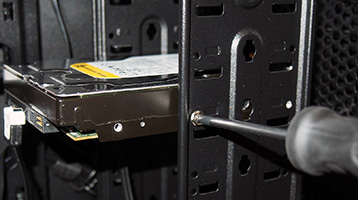
Installing a Mechanical Hard Drive on a Desktop.
Although you can use external hard drives to free up space on your desktop, it’s not too difficult to install a new internal hard drive, and internal drives are less likely to get dropped or misplaced.
Here’s how to do it yourself.
1. Mounting Options — First, you need to look at your mounting options. There are a few different ways to mount, depending on your machine. You will have either a drive cage or a drive bay, which are usually located at the lower front, near the fans, and the drive connectors are usually pointing towards the rear. Your machine may have the cage/bay in a different location or orientation, so the first step will be to find it.
2. Mount the Drive — To secure the drive to a cage, you’ll typically need four screws on the sides of bottom of the drive. Some machines have trays that hold the drive with pins instead of screws. You’ll want to leave as much space as possible between the new drive and the existing drive, to allow airflow to go over the tops and bottoms. If you can install them in front of a fan, that’s ideal.
3. Connect the Drive — Mounting the drive is the hardest part. Connecting it will seem like a piece of cake once you have that done. Unless you’re installing on a server, your hard drive will probably use a SATA interface, which uses cables that fit on the drive and the motherboard only one way — so you can’t really make a mistake. Connect one end of the SATA cable to the drive and the other to a SATA port on your motherboard. Then connect the drive to your power supply unit (PSU).
4. Prepare the Drive — After mounting and connecting the drive, power up your system and enter the BIOS/UEFI. (If you don’t know what it is, you can usually access it by pressing the DEL or F2 keys right after powering up the system.) Otherwise, consult your motherboard’s manual. A window will appear. Go to the standard Systems Settings (or Integrated Peripherals > SATA) and you should see all the drives installed in the system. If your new drive isn’t listed, shut down the computer and double-check all of your connections, then try again. If the drive still isn’t listed, you will need to plug your SATA cable into a different port on the motherboard.
5. Confirm that Windows Recognizes the Drive — Open the Device Manager, and locate the drive in the Disk Drives section. (The New Hardware Found wizard may appear). Next, simply partition and format the drive.
Installing a new hard drive doesn’t require too much technical knowledge, but you’ll need to be able to locate elements on your individual machine.
Need help?
If you have any questions installing your new hard drive? Just give us a call at 864-881-1675.

